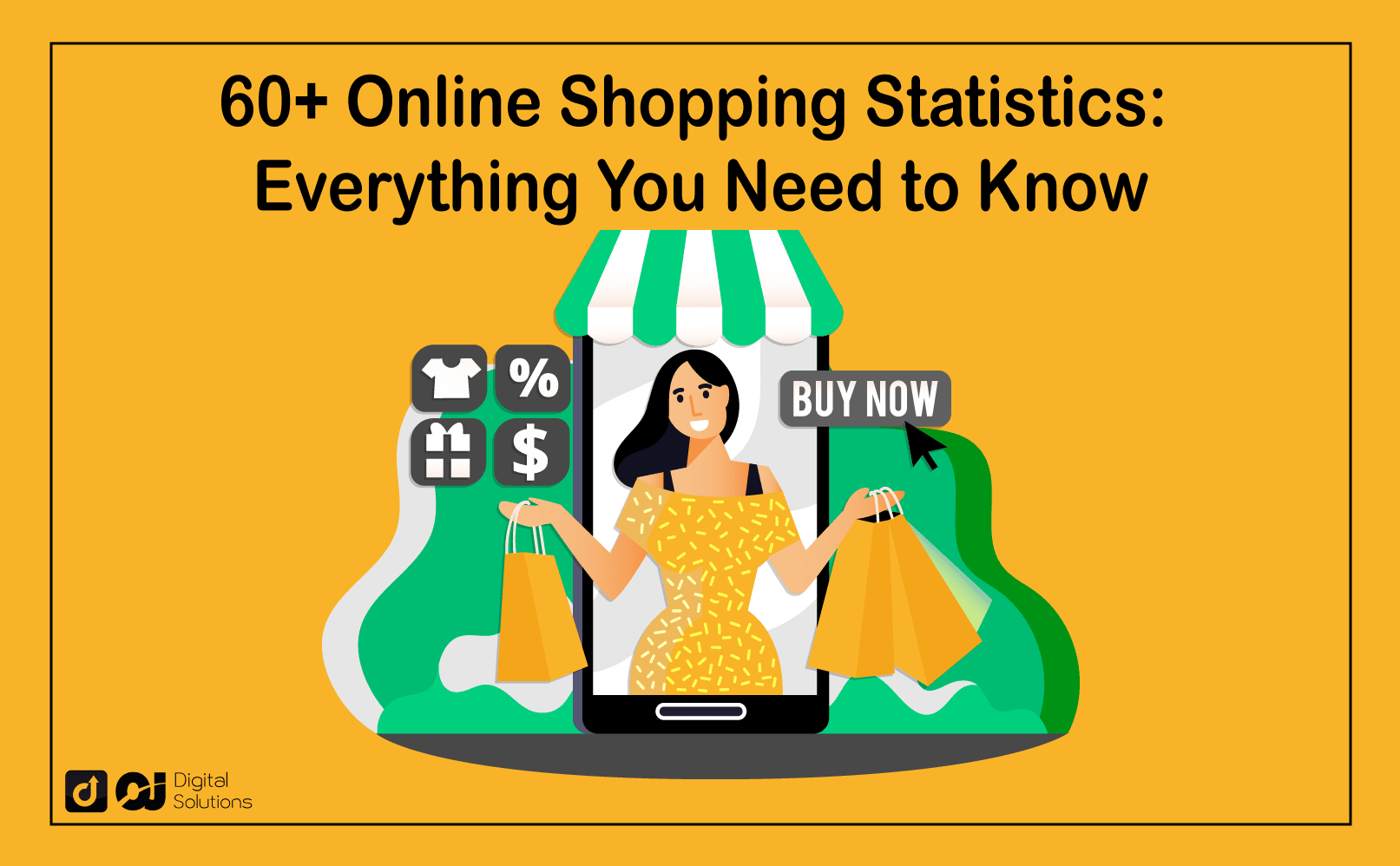More and more people are seeing the convenience and ease online shopping offers compared to traditional brick-and-mortar stores.
How many people shop online? According to Statista, approximately 80% of American consumers shop online. That’s more than 263 million people.
With that many online shoppers, it’s essential to understand some of the statistics behind this phenomenon.
In this guide, I’ll discuss some of the latest and most interesting online shopping statistics.
I will also explore several factors that led to the growth in the popularity of online shopping.
Let’s get started.
What Is Online Shopping?

Online shopping refers tothe process of buying goods or services over the internet, typically from a retailer’s website.
This form of commerce has grown tremendously in recent years.
Many different factors have contributed to the rise of online shopping, including:
- the widespread availability of high-speed internet connections
- the increasing popularity of mobile devices
- the growing number of e-commerce online retailers
Regardless of the reasons behind its growth, it is clear that online shopping is here to stay.
It will continue to play an important role in our society for years to come.
Online Shopping Statistics
Now, let’s dive into the data about the various aspects of online shopping.
General Online Shopping Stats

1 – Over 263 million Americans or 80% of the population make online purchases. Statista estimates that the number will increase to 291.2 million by 2025.
2 – What do people buy the most online? Electronics, fashion, and media are the three most popular online shopping groupings in the United States.
3 – It’s also important to understand the demographics of online shoppers. As of February 2020, millennials between 25 to 34 years old made up 20.2% of online customers in the United States.
The next major online shopper demographic in the United States was between ages 35 and 44. These made up 17.2% of all online shoppers.
4 – Insider Intelligence predicts that US ecommerce sales will grow by 16.1% and reach $1.06 trillion in 2022.
5 – To date, 69% of Americans have made an online purchase, and 25% of them do so at least monthly.
6 – According to a 2022 Raydiant study on consumer behavior in the United States, 56.6% of survey participants prefer online shopping over in-person shopping.
That represents an increase of about 10% from the data for 2020.
7 – According to a survey, 22% of consumers worldwide shop online once per week. 29% of people shop online once a month, and 27% buy online once every two weeks.
8 – The ease of online shopping is the main factor driving consumer spending. In a Statista survey, 56% of respondents cite direct delivery services as a pro.
Reduced prices, constant accessibility, and a wider selection of products are also on the list.
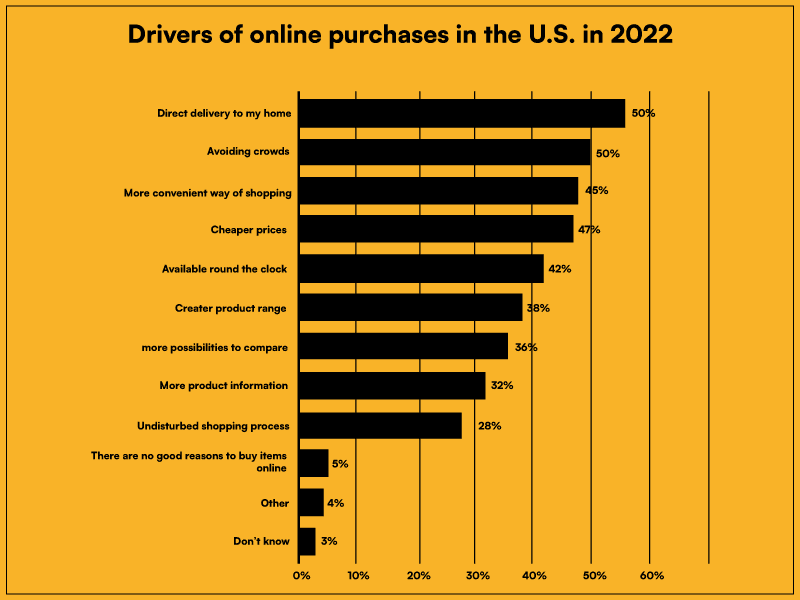
9 – On average, online shoppers spent $3.46 for every visit in the second quarter of 2021 across various retail categories.
This includes home appliances, luxury, health and beauty products, and active and casual apparel.
10 – More than 45 million consumers in the United States used voice technology for their buying experience in 2021.
This shows a growth of 120%, up from about 20 million in 2018, as per Voicebot’s Voice Shopping Consumer Adoption Report 2021.
11 – 59% of consumers conduct online research before making a significant purchase to guarantee they are selecting wisely.
12 – When making a purchase, about 70% of consumers consider the accessibility of physical stores.
13 – 74% of in-store customers admitted that they looked up information about in-store purchases online first.
This includes the nearest store, locations, what’s available nearby, hours, wait times, directions, and contact details. In addition, 46% of customers checked inventory online before visiting the store.
14 – 45% of consumers in the United States cited making products simple to find as a crucial aspect of the experience of shopping online.
From this survey, your website should have a notable search bar. It should also be set up with categories and subcategories for navigation.
Also, think about displaying related products next to your products.
15 – Data shows that the need for excellent product photos and in-depth, high-quality product descriptions ranks second in importance (39%).
This emphasizes the importance of having clear images and product descriptions.
16 – Before purchasing an item online, over 70% of online shoppers typically read one to ten customer reviews. Just under 10% of consumers never read customer reviews before making a purchase.
17 – A consumer marketing experience study found that 61% of respondents would likely pick a store that provides augmented reality. 71% stated that they’d shop more if they could use AR apps.
18 – Eighty-seven percent of younger shoppers want financing options for buying online.
BNPL (buy now, pay later) solutions like Sezzle, Splitit, Klarna, and Affirm help boost online retail sales by providing recurring monthly payments.
19 – Experts expect mobile ecommerce shopping to generate more than 10% of all retail sales in the US by 2025.
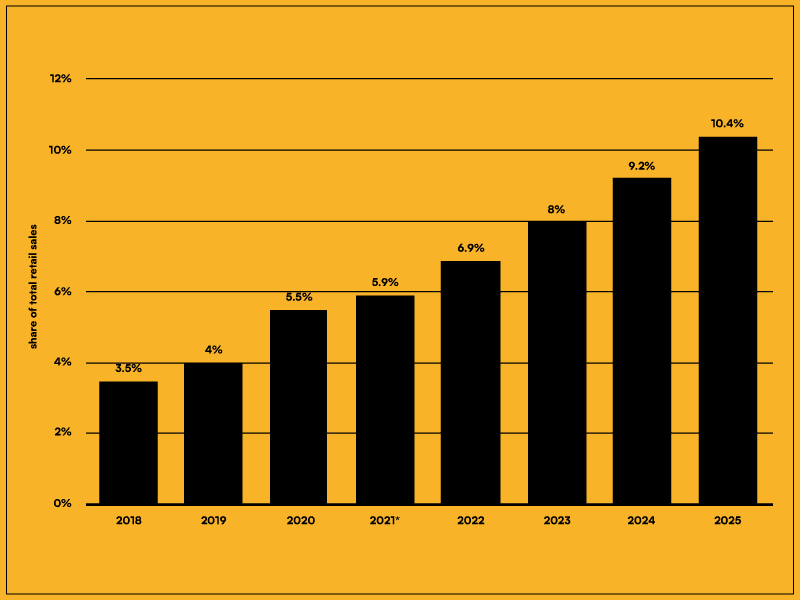
20 – According to a 1,500-person consumer survey by Intuit, 70% of shoppers either only buy online or shop both in-store and online.
Many consumers (57%) make local purchases to keep their money in their communities. Others (38%) prefer to support regional artists and regional nonprofits (19%).
Social Commerce

21 – Younger generations are already using social media to make online purchases. It appears that this trend will continue.
According to an eMarketer study, there will be 108 million social buyers in the United States by 2025. This is up from 60.6 million in 2019, an increase of over 75% in just a few years.
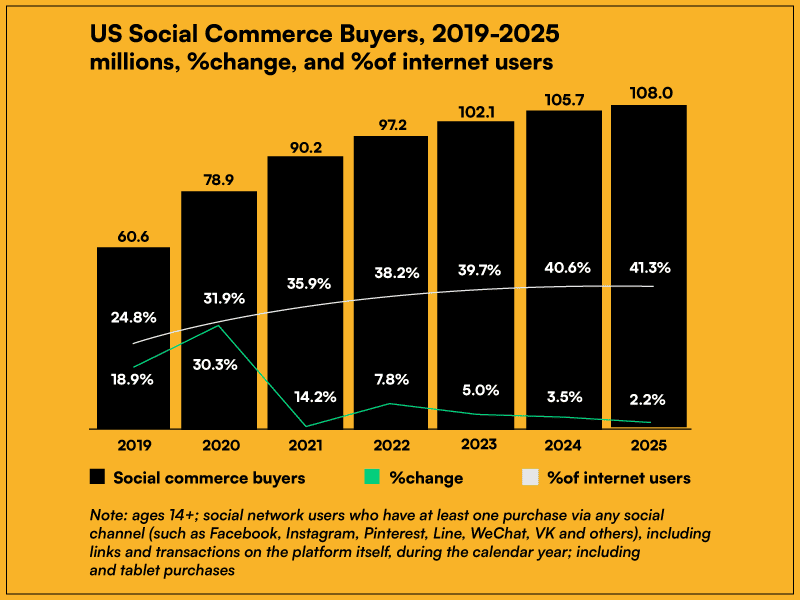
22 – Influencer marketing dominates social commerce, which heavily relies on user-generated content (UGC).
71% of consumers in the United States said that social media posts from acquaintances or friends had an impact on their purchase decisions.
This proves that UGC affects brand advertising significantly.
23 – According to Bazaarvoice’s 2021 Shopper Experience Index, almost one-third of American consumers use social media to learn about new products.
24 – In a Net Solutions survey, 55% of participants said they had bought a product online after learning about it on social media (11% did so right away; 44% did so later).
25 – By the end of 2020, 39% of people aged 18 to 34 had bought something on social media, and 15% more did so frequently.
A total of 35% of adults in the United States say they have purchased something online (an 8% increment since April 2020).
26 – The global penetration rate of digital consumers as of 2018 is 47.3%. When examining statistics by gender, a study by Optinmonster found that 72% of shoppers are women. 68% are men, a relatively small difference.
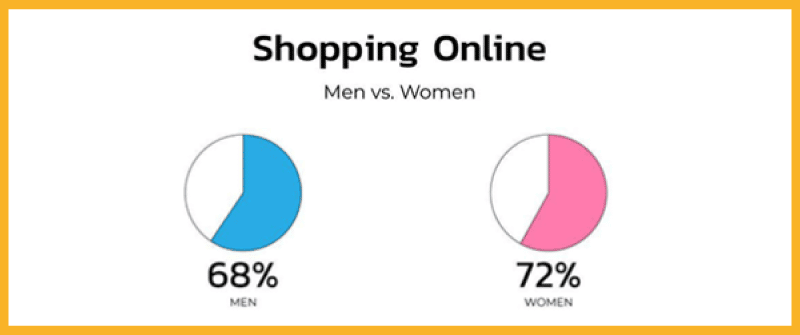
27 – According to estimates, there will be 1.92 billion digital consumers in 2019. eCommerce sales will make up 14.1% of all total retail sales globally.
28 – According to Insider Intelligence, social commerce will grow by 24.9% in 2022.
29 – According to a survey conducted in April 2021, 51% of participants frequently made purchases from Facebook.
More than 47% of social media users between the ages of 16 and 34 reported doing
so on Instagram.
30 – 86% of US marketers and agency professionals reported enabling shopping functions in their influencer marketing campaigns.
The most common function among these is linking to the brand’s own website.
31 – Ninety-three percent of US executives reported their plans to move their businesses’ eCommerce efforts to social media.
32 – Seventy-one percent of small businesses intend to sell on social media platforms by 2023.
Online Shopping on Mobile
33 – Mobile commerce (m-commerce) revenue reached $359.32 billion in 2021, up 15.2% from 2020.
According to projections, online m-commerce sales will likely reach $728.28 billion by 2025. Additionally, it will represent 44.2% of US retail ecommerce sales.
34 – According to Mordor Intelligence, the mobile payments market will likely see 29.5% growth by 2027.
35 – Emarketer predicts that the number of individuals using mobile payments in the US will rise to 80 million.
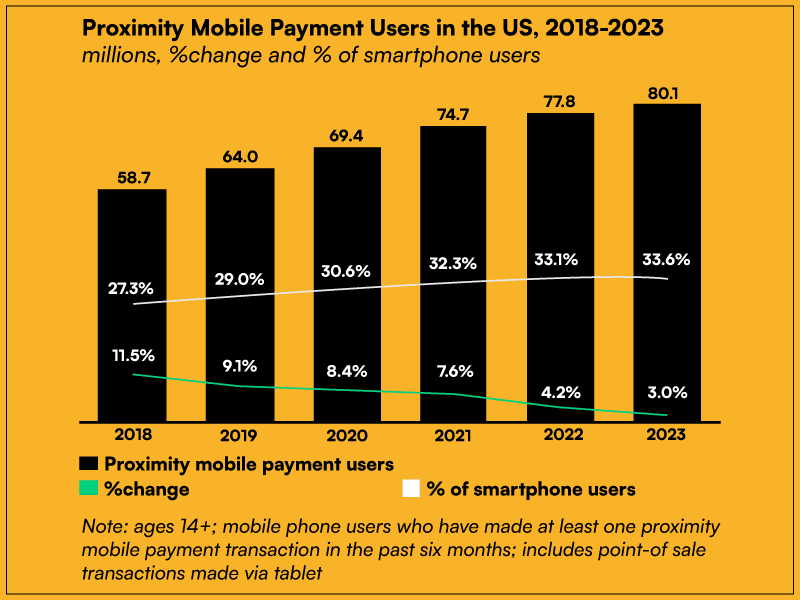
36 – Small online retailers may soon experience mobile conversion rates up to 30% higher than those of larger retailers.
37 – Sixty-seven percent of internet users admit to using their smartphones to browse stores for fun most of the time.
38 – Forty-nine percent of Americans have used a shopping app to compare prices.
39 – While only 12% of consumers find m-commerce convenient, about 90% of digital buyers think mobile shopping can be enhanced.
40 – A staggering 49% of people shop using their phones. Therefore, mobile devices will also generate 49% of your traffic.
41 – Several factors hinder customers’ mobile shopping experience. These include:
- security concerns (42%)
- the inability to click on links and pages because they are too small (67%)
- interruptions from apps, messages
- other programs (36%)
42 – Responsive web design plays a significant role in customer satisfaction. According to Sweor, 57% of internet users state they won’t recommend a business whose website is poorly designed on mobile.
Moreover, 85% of adults say that a company’s mobile website should be just as good, if not better, than its desktop website.

43 – In a Statista survey, 30% of participants said they would like to always be able to pay with their smartphones. Credit cards and digital payments are currently the most popular online payment methods.
44 – Mobile devices comprised 58.99% of web traffic in Q2 of 2022.
45 – An OuterBox study found that 79% of smartphone users have purchased online via mobile devices over the last 6 months.
46 – Twenty-one percent of device users access retail shopping apps multiple times a day, and 35% access them multiple times a week.
Abandoned Cart Stats
47 – Eighty percent of all online shopping carts are typically abandoned.
48 – Cart abandonment emails have an average conversion rate of 15.22%, as per Barilliance.
49 – The average abandonment rate for eCommerce businesses is 69.99%.
50 – Businesses worldwide lose a whopping $4.6 trillion from abandoned shopping carts.Of these losses, $260 billion is recoverable.
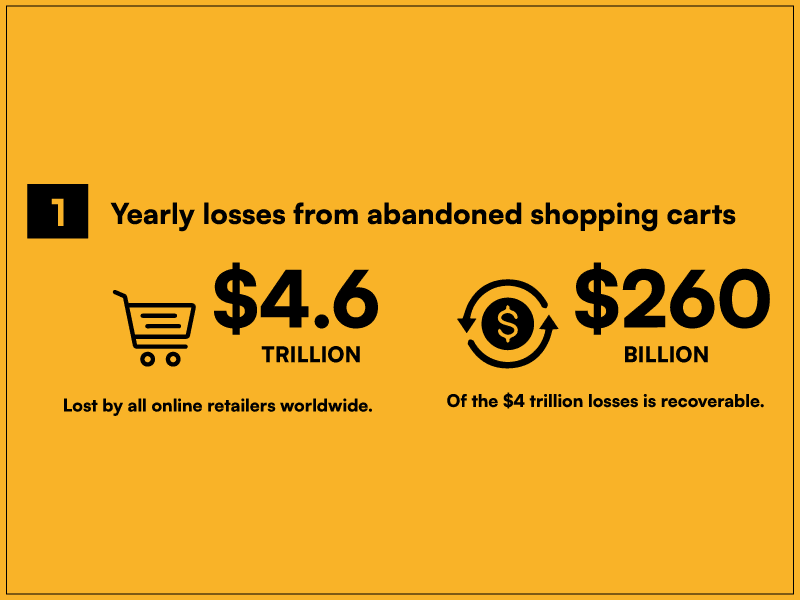
51 – According to a SaleCycle report, abandonment occurs the most on Sundays. The peak hour per day is at midnight.
On the other hand, shoppers rarely abandon their carts on Fridays, and abandonment occurs least at 9 A.M.
52 – Fifty-five percent of cart abandonment is due to unforeseen costs. Therefore, it is better for the online seller to be truthful and upfront about all the costs.
53 – Thirty-four percent of customers cite mandated account creation as another reason for cart abandonment.
Others cited a long and tedious checkout process (26%), unclear pricing (21%), and a lack of trust with credit card information (17%)
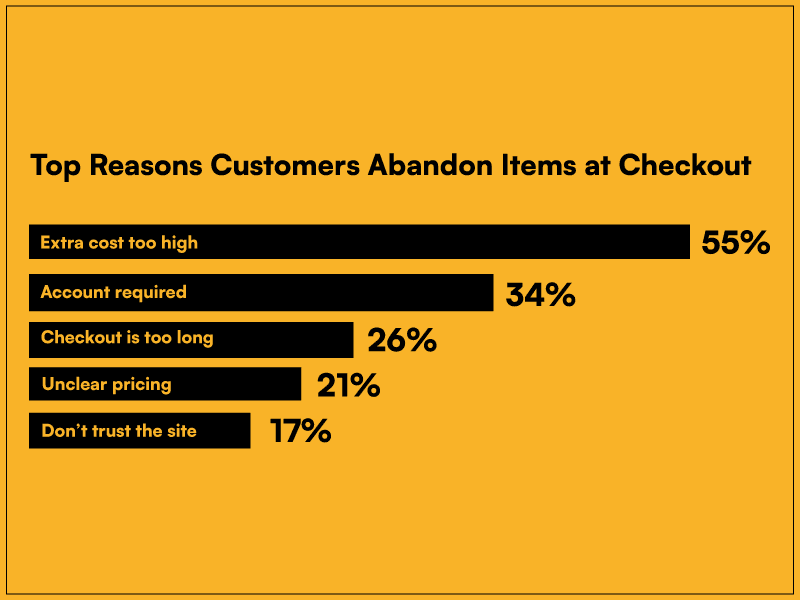
54 – The speed of the website matters, too. A report found that 22% of customers leave their carts due to a slow or crashing website.
55 – The average open rate for emails sent due to cart abandonment is 45%. Twenty-one percent of these have click-throughs. For your business, this can aid in lowering shopping cart abandonment.
Online Shopping on Amazon
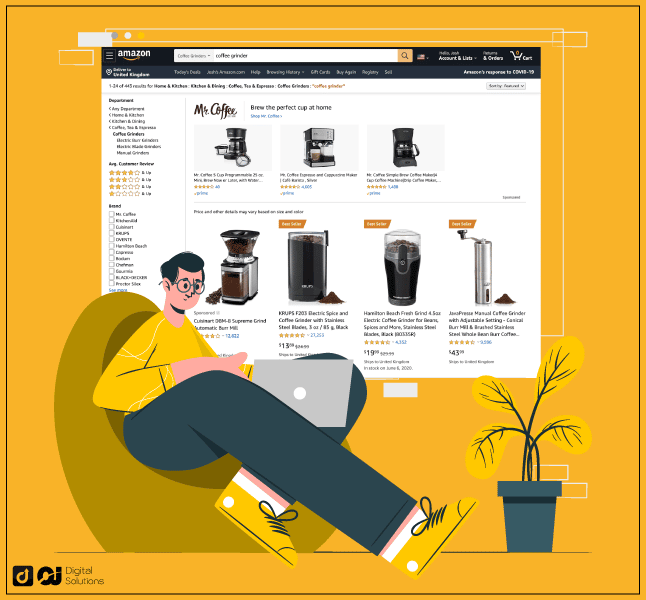
56 – According to a 2021 Wunderman Thompson study, 57% of buyers use Amazon to find products.
57 – In the United States alone, Amazon records 2 billion monthly visits. This is nearly three times as many as eBay, which comes in second with only about 700 million monthly visits.
58 – About 50% of customers visit Amazon at least once every week and are incredibly loyal to the website.
More than half of US consumers begin their shopping on Amazon. Sixty-three percent conduct product searches there first before turning to search engines.
59 – With more than 95 million Americans claiming a Prime membership, the United States Amazon Marketplace is enormous. They account for nearly two-thirds of Amazon’s US customers overall.
60 – When buying online, consumers cite various reasons for shopping at Amazon. Sixty-six percent of US customers shop at Amazon mainly because it satisfies all of their needs.
This is followed closely by getting free shipping thanks to Prime membership (56%).
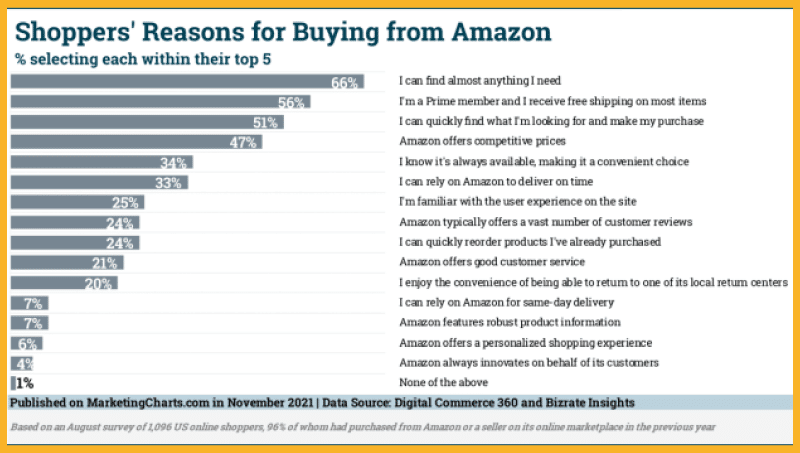
61 – More people than ever sign up for Prime memberships on Prime Day. A little over 18% also convert and splurge the most on purchasing items, more than Black Friday and Cyber Monday combined.
62 – Only around 2% of users utilize Alexa to make new purchase decisions. Instead, they ask her questions and check the progress of their orders.
It demonstrates how much consumers still value seeing and learning about products before making a purchase.
63 – In August 2013, Amazon experienced a 40-minute outage. They lost online sales worth almost $5 million in that brief period.
This shows how important it is for your online shopping platform to be stable and secure at all times.
Online Shopping Best Practices
Based on the online shopping statistics above, there are several basic best practices you can follow to ensure your customers have a positive experience.
Be Upfront About All Costs and Shipping Fees.
Many customers abandon their shopping carts due to surprises at checkout. Thus, it is crucial to be transparent about all costs from the start.
Offer a Variety of Payment Options.
Credit cards and digital payments are currently the most popular online payment methods. However, a person shopping online would want alternative payment methods.
You should also offer alternative options like PayPal or Apple Pay. This ensures that all customers can purchase from your site.
Use High-Quality Images and Detailed Product Descriptions.
Customers want to quickly and easily browse your products online. Thus, providing them with clear, high-resolution images and detailed product descriptions is vital. This will help them make informed decisions.
Ensure a Fast and Secure Checkout Process.
It is important to have a quick and secure checkout process that online shoppers can complete in just a few clicks. This helps avoid cart abandonment and boost conversions.
It may require implementing additional security measures. Examples would be two-factor authentication or providing multiple shipping options.
Utilize Mobile-Friendly Features.
Optimizing your site for mobile devices is essential to meet the needs of today’s mobile-shopping consumers.
Optimization may include features like prominent search bars, easy-to-click buttons, and large product images.
Offer Discounts and Other Incentives.
To drive higher sales and encourage more frequent shopping, offer discounts and other incentives to online shoppers.
This may include free shipping or loyalty programs. It can help you build stronger customer relationships and drive long-term growth for your business.
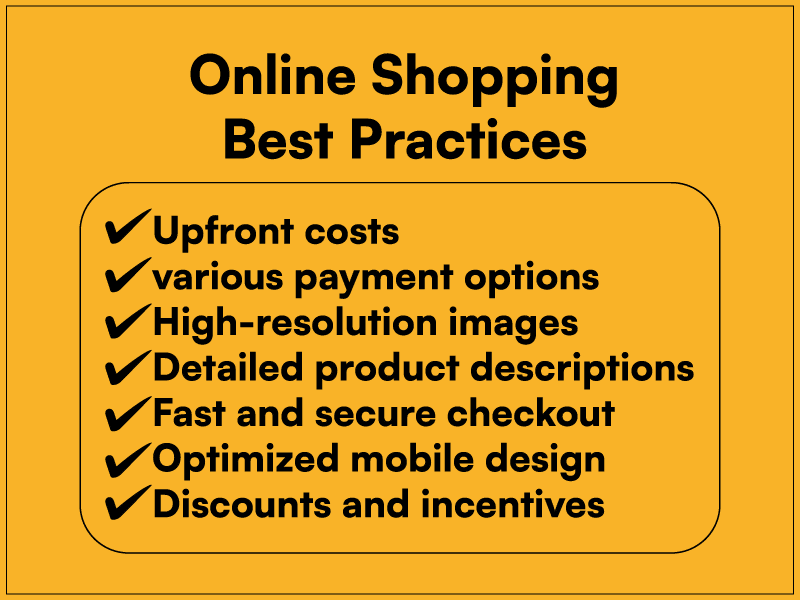
Frequently Asked Questions (FAQs)
What Is the Biggest Concern About Online Shopping?
One of the biggest concerns about online shopping is security. Many consumers worry that their financial data could be compromised.
They also worry that they might experience fraud when purchasing online.
Additionally, many online shoppers find navigating websites and completing transactions on mobile devices difficult.
This can also be a source of frustration for shoppers.
With increased efforts from retailers and online platforms to improve their website user experience and security, many people are starting to feel more confident about shopping online.
Who Is the Target of Online Selling?
The target audience for online selling includes consumers of all ages and backgrounds.
However, younger consumers are particularly likely to use social media and other digital platforms to find and purchase products.
This is partly because they tend to be more comfortable with technology. Still, it also reflects the growing popularity of e-commerce overall.
What Factors Influence Online Shopping?
Several factors can influence consumers’ decisions to shop online, such as:
- Convenience
- Pricing
- Product selection
- Quality
- User experience
Other important considerations include:
- Security concerns
- The ability to easily navigate websites and complete transactions on mobile devices
- The availability of convenient payment options
To attract and retain customers, retailers must improve these factors and provide a positive online shopping experience.
This may involve:
- Investing in robust security measures
- Creating user-friendly websites and mobile apps
- Offering a range of payment options that are simple and secure
Ultimately, the goal is to create an enjoyable shopping experience that encourages customers to keep coming back for more.
Why Do Most Online Stores Fail?
There is no single reason why online stores tend to fail, as there are a variety of challenges that they may face.
Some common causes include:
- Difficulty attracting and retaining customers
- Lack of inventory or product selection
- Poor customer service
- Inadequate security measures
- Difficulties managing operations and logistics
Additionally, many business owners may struggle with marketing their products effectively and consistently attracting new customers.
To be successful, an online store must focus on addressing these challenges.
The online store must also continuously improve its offerings to meet today’s consumers’ needs and expectations.
Is Online Selling Still Profitable?
Yes, online selling can still be highly profitable, as more and more consumers are choosing to shop online, thanks to its convenience.
This is also due to factors such as competitive pricing and a wide selection of products.
Technological advances have made it much easier for business owners to run their operations effectively, market their products, and reach new customers.
While there are risks involved with selling online, with the right business model and approach, online selling can be a very lucrative opportunity.
Is Online Retail the Future?
Although there has been some concern that online retail may eventually decline in popularity, it appears that this is unlikely to happen in the near future.
In fact, research suggests that e-commerce sales are continuing to grow year over year.
Many experts predict that they will continue to do so for the foreseeable future.
This suggests that digital shopping platforms such as Amazon, eBay, and others will continue to have a strong presence in consumers’ lives for the foreseeable future.
Conclusion
I hope these online shopping statistics have shown you that e-commerce is a booming industry and one that shows no signs of slowing down.
Whether you’re a seller looking to get in on the action or a buyer looking to find the best prices, there is something out there for you.
There are so many options available and such high levels of competition between sellers.
Therefore, you must do your research before making any major online purchases.
You can also learn more about Gen Z shopping habits to inform your online shopping strategy.

